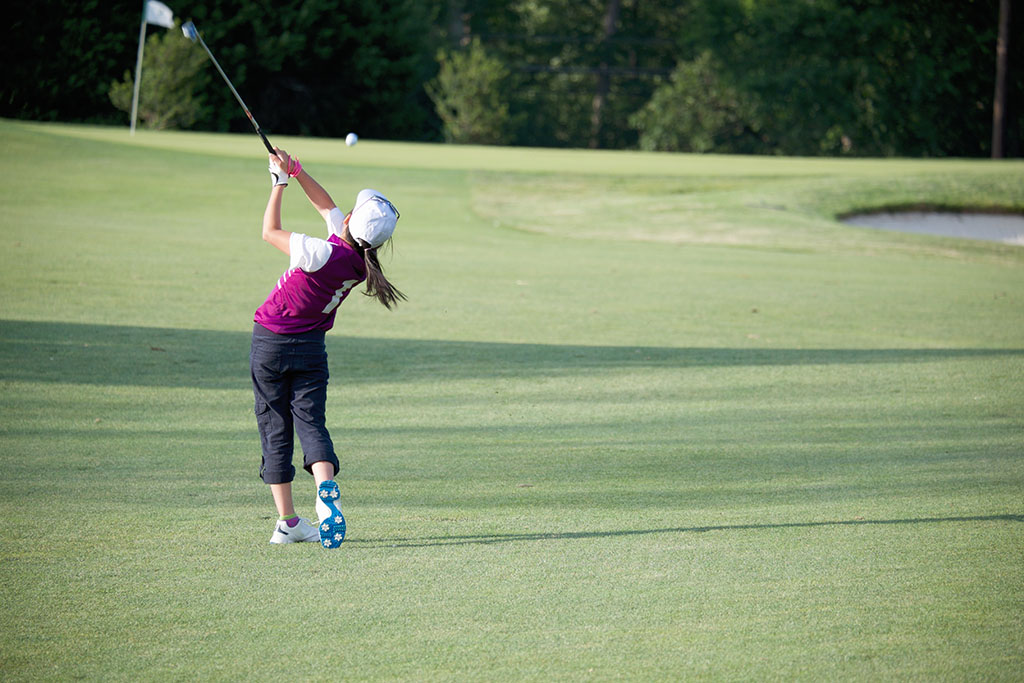
To many people, golf is seen as a male-dominated sport, a ‘men’s only club’ where business deals are negotiated on the green. So, why is it that this sport is so often seen as being riddled with gender stereotypes and sexism, at both a grassroots and professional level, not to mention the significant pay inequality for the pros?
With England’s Lionesses’ currently participating in the 2023 World Cup, being held in Australia & New Zealand, we’re exploring whether women’s golf in the UK will ever be able to match the same level of interest and excitement that football and other professional female sports have achieved.
While some might argue things have improved for women in golf – it’s clear the sport has a way to go to champion women as they do men and grow the sport at a grassroots level for both adults and juniors.
Historical Perspective
The origin of golf dates back to the 15th century in Scotland where, in its early days, players would attempt to hit a pebble over sand dunes and around tracks using a bent stick or club. King James IV of Scotland (1473 – 1512) became the first golfing monarch and thanks to his royal seal of approval the game grew in popularity throughout 16th-century Europe.
It was recorded that Mary Queen of Scots (1542 – 1567) was the first female golfer and it was during her reign that St Andrews Links golf course was built. However, the first recorded golf tournament for women wasn’t until 1811, which was held in East Lothian, Scotland, organised by Musselburgh Golf Club for the wives of the local fishermen. Another 55 years after this, The Ladies Club St Andrews was established as the first women’s golf club.
One of golf’s earliest pioneers was Issette Miller, who took up the sport in 1886, as the only female member of Wimbledon Golf Club. Issette was the first honorary secretary of the Ladies Golf Union (LGU) which was founded in 1893.
Issette’s greatest achievement was that she founded the first handicapping system for women and men. Initially, it was snubbed by British golfing authorities while the US adopted the system. Eventually, British golfing authorities succumbed to the system, which is still used today.
Gender Disparity and Challenges Faced by Women in Golf

The overarching industry message is that golf is about equality, diversity, and inclusion – yet is this really what’s on offer at every club across the UK and even worldwide?
For example, it wasn’t until 2014 that the Royal & Ancient Golf Club of St. Andrews voted to allow women as members for the first time in its 260-year history. While Augusta National, host of the annual Masters tournament, only began accepting female members in 2012. It’s surprising that such well-established clubs weren’t more forward-thinking and able to lead the way sooner in welcoming women as members.
Indeed, even though clubs are now inclusive of women in the UK, a previous study by Sports Psychology Limited (SPL) suggested that golf clubs aren’t doing enough to make their websites appealing to women, and inclusive for golfers of all genders, races, and ages.
Clubs should understand that for anyone wanting to get into golf, one of their first touchpoints is either going to be a club’s website or social media channels. If a person doesn’t feel they’re being represented fairly then it’s likely they may overlook that club in favour of somewhere else.
For women that already play at club level, one of the biggest frustrations for them is the long-standing tradition of the ‘ladies tees’. Traditionally, the yellow and white tees have been reserved for male players in a further back position, while the red tees are for women in a slightly further forward position.
If you were to ski, you choose a route that suits your ability, not gender – why should golf be any different? It also highlights the fact that male veterans or junior golfers also don’t have the choice to tee off from a slightly more forward position.
Thankfully, some clubs have adopted a more ability-based tee system which encourages people to play from a tee that allows them to enjoy the game the most. It’s this change in terminology that will help make the sport more inclusive.
Another obstacle for women is the issue around childcare for working mothers who want to get into golf or that have played before and want to get back into the sport. Currently, this isn’t something that’s considered at many clubs.
Unlike other sports or fitness-based activities, a game of golf takes hours and therefore, relies on a support network to allow for working mothers to play. Ideas such as onsite creches or for slightly older children offering junior training while parents play a game could help encourage more women into the sport.
Pay Inequality in Golf

Becoming a professional female golfer is a huge accomplishment but is certainly no mean feat due to the challenges these women face to be at the top of their game.
To be a competitive female golfer is not much different to their male counterparts; they will need to secure funds from sponsors or investors to help cover the cost of expenses such as travel, caddies, entry fees to competitions and more. However, even if they’re at the top of their game, the prize money is still considerably disproportionate than it is for men.
This year’s United States Women’s Open total purse money was $11 million, with the winner Allisen Corpuz taking home $2 million as her first-place cheque. In contrast, the Men’s US Open saw male golfers competing for a total purse of $20 million, almost double what the women’s prize fund was. While the winner took home $3.6 million, up from $3.15 million a year ago.
It’s a similar story for the British Open. In 2022, for men, the total prize fund for The Open stood at $14 million, with first place taking home $2.5 million. At the Women’s Open, the total prize pot was $7.3 million with the winner taking home $1.095 million.
While winning these events can establish a successful career for women as professional golfers, those further down the ranks are likely to struggle with the disproportionate pay and therefore, may have to work to cover their expenses alongside their rigorous training schedule to climb the ranks as a professional golfer.
Initiatives and Progress

The intervention of certain organisations and individuals to promote women’s golf means accessibility to the sport and equality is improving.
Thanks to the 2010 Equality Act, a golf club cannot restrict female members to playing only on certain days if male members are permitted to play every day. This is a big step for women’s golf as previously clubs would often give ladies time on the course which was completely unrealistic for women that work and/or are parents.
Other positive reports of progress and initiative include:
- In May 2018, the R&A launched the Women in Golf Charter, which aims to encourage clubs and counties to sign up to the charter and select as many of the commitments that they want. The charter’s long-term drive is to bring more women and girls into the game.
- The World Handicap System, which launched in England on 2 November 2020. The new handicap system eclipses the previous measures to be a single, consistent measure of playing ability to make the game more inclusive and equitable across the world.
- The number of women playing golf is on the rise. The number of females playing the game grew in Great Britain and Ireland, up from 1.47 million in 2020 to 1.71 million in 2021
- Girl Golf Rocks is a national programme in England with around 200 host clubs/facilities taking part. It aims to encourage beginner girls aged 5-18 to learn and play golf in a fun and friendly way.
Changing the Narrative
We live in a world where change is constant and while this does ring true in the golf community, it’s felt at a slower pace than in other sports. However, thanks to a group of female trailblazers it has become their mission to make sure this momentum doesn’t fizzle out. So, let’s find out more about these women:
- Yvonne Brooke, Founder of The Ladies Golf Lounge: In May 2020 Yvonne set up The Ladies Golf Lounge female-only Facebook group, which is a great support network for women that are new to the sport or who are looking for like-minded individuals. She’s championed helping women get into golf and hopes that by bringing more females into the sport it can help break down barriers and change a person’s perception of the sport.
- Jasmine, better known as The Jazzy Golfer, founder of the UK Women’s Golf Community (UK WGC): In 2017 Jasmine launched her social alias ‘The Jazzy Golfer’ to document her journey as a beginner’s golfer. Now six years on and she’s founded UK WGC which is another Facebook community-based initiative for women that play golf. They also hold regular meetups across the UK designed to bring women and girls together to play golf.
- Nicole Wheatley, Founder of Medi8 Golf & The Women in Golf Awards, co-owner of Golf Marketing Hub and Producer / Writer of Breaking with Tradition: Nicole’s documentary ‘Breaking with Tradition’ aired in December 2022. It examines the hidden histories and untold stories of women in golf. It’s inspiring to hear from people in various roles in the golf industry to understand the challenges and hurdles women have overcome. Nicole is also a keen champion of clubs considering offering childcare to allow parents to get out onto the course.
Thanks to these like-minded individuals, women’s golf in the UK has a great support network to help encourage and nurture new females in the sport, which in turn should help stamp out some of the sexism and barriers that have put women off in the past.
Fulford Golf Club, Chair of Greens Interview
To gain some fresh perspective on what it’s like to have a career within the golf industry as a female as well as a player, here at The Insurance Emporium, we spoke to Tracey Maddison, Chair of Greens at Fulford Golf Club.
She said: “Things are changing – but it’s just not quick enough. Here at Fulford we have around 420 men joined as full members whereas there’s only 52 female full members, so women only account for 12% of our members. If we don’t get more people playing, more women playing – you know one of our biggest incomes is subscriptions and visitor income, clubs like ours will not survive.
When asked about the challenge of how we get more females on the fairways, Tracey said: “If you can’t see it you can’t be it…There’s a big gap between women in their 20s, 30s and 40s but it is changing and more women are wanting to get involved, but I think it’s just knowing how and I think these Facebook groups [the ladies golf lounge and UK Women’s Golf Community] are really helpful for newcomers into it… I feel like I’m on a crusade, it’s a brilliant sport and I just want people to enjoy it!”
Making it easier for people to access and see women’s golf firsthand at a professional level could also help the sport as Tracey continues: “The women’s game, many club golfers would find that very relatable, seeing how far the women professionals strike the ball, when some are only 5 foot tall, is fantastic and shows you how good they are. Their level of athleticism is to be admired, just like the men, they are at the top of their sport and many men and women club golfers would benefit from watching them play.”
When it comes to change, we discuss how it’s important more women are represented in senior positions, especially at club level, as Tracey says: “I’ll go into the directors’ meeting and we now talk about the white tees and red tees not the men’s tees and women’s tees, as the terminology changes so do perceptions. It’s all about having that representation, if you’re not sitting around the table, you can be forgotten about. And at the same time, you learn a lot about the men’s side of it as well, which is interesting and together we form a team. We all have strengths, weaknesses, and inputs.”
Speaking on what her biggest aspiration would be, Tracey answered: “I would just like it to be more equal. People keep saying to me, Tracey will you become captain of the club and I say when we have A captain of the club, and it doesn’t matter who they are – it’s just the right person for the job, then I’ll put myself forward for that. Why do there have to be joint captains?”
Women playing golf spans back hundreds of years and is steeped in history. It’s amazing to look back and see how far it’s come but by no means is the sport where it should be. Women still have a fight on their hands to achieve equality within the sport and equal pay opportunities at a professional level.
However, thanks to changes in society and the movements within the online communities to break down pre-conditioned perceptions and barriers and make the sport more inclusive and accessible for women and juniors we believe women’s golf will have its day and the sport will continue to flourish as it has in recent years.
Golf is a sport that can be played and enjoyed whatever your age, however, once you’ve become invested in it both physically and financially you might want to think about Golf Insurance. Selecting the level of cover that suits your needs best could mean, whether you’re teeing off here in the UK or even aboard, you’ve got cover for both on and off the course.
All content provided on this blog is for informational purposes only. We make no representations as to the accuracy or completeness of any information on this site or found by following any link on this site. We will not be liable for any errors or omissions in this information nor for the availability of this information. We will not be liable for any loss, injury, or damage arising from the display or use of this information. This policy is subject to change at any time.
We offer a variety of cover levels, so please check the policy cover suits your needs before purchasing. For your protection, please ensure you read the Insurance Product Information Document (IPID) and policy wording, for information on policy exclusions and limitations.


